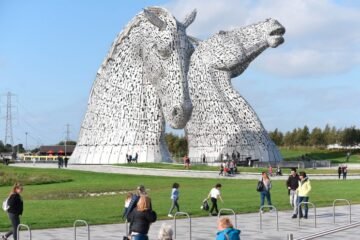Ebenezer Scrooge is one of the most iconic characters in literature, created by Charles Dickens in his 1843 novella A Christmas Carol. The miserly and cold-hearted businessman who despises Christmas and is transformed by the visit of three spirits has become a symbol of redemption and festive spirit. But who was the real person behind this fictional character? And why did Dickens choose to name him after a Scottish corn merchant whose grave he stumbled upon in Edinburgh?
The Misread Tombstone
The story goes that in 1841, Dickens was visiting Edinburgh for a lecture and decided to take a walk along the Royal Mile, the historic street that connects the Edinburgh Castle and the Holyrood Palace. As he passed through the Canongate Kirkyard, a cemetery that dates back to the 17th century, he noticed a gravestone that caught his attention. It belonged to Ebenezer Lennox Scroggie, who had died in 1836 at the age of 70. Scroggie had been a successful corn trader and vintner, who had supplied Captain James Cook’s ship Endeavour as it charted the Pacific. He had also served as Edinburgh’s Lord Provost, the equivalent of a mayor, for two years. On his tombstone, he was described as “a meal man”, meaning a corn merchant.

However, in the dim light of the evening, Dickens misread the inscription as “a mean man”. He was struck by the contrast between the prosperous and respected life that Scroggie had led and the harsh judgment that his epitaph seemed to convey. He later wrote in his personal notebook that “to be remembered through eternity only for being mean seemed the greatest testament to a life wasted.” He was so intrigued by this idea that he decided to use it as the basis for his next story, which he wrote in just six weeks and published in time for Christmas 1843. He changed the name of his protagonist slightly, from Scroggie to Scrooge, and created a character who was the opposite of the real-life corn merchant: a miser who had no friends, no family, and no joy in life.
The Lost Grave
Dickens’s story was an instant success, and Scrooge became a household name. The novella has been adapted into countless films, plays, musicals, and cartoons, and has influenced the way people celebrate Christmas around the world. However, the grave that inspired Dickens to write his masterpiece was not so fortunate. In 1932, the Canongate Kirkyard underwent some construction work, and Scroggie’s tombstone was removed and lost. No one knows what happened to it, and no trace of it has been found since. The only evidence of its existence is a photograph taken by a local historian in 1908, which shows the inscription clearly.
The disappearance of Scroggie’s grave has added to the mystery and fascination surrounding his life and his connection to Dickens. Many people have tried to find out more about him, and some have even claimed to be his descendants. In 2014, a political economist named Peter Clark published a book titled The Real Life of Ebenezer Scrooge, in which he revealed new details about Scroggie’s career, personality, and achievements. He argued that Scroggie was not only a successful businessman, but also a philanthropist, a patriot, and a bon vivant, who enjoyed parties, women, and wine. He was also known for his eccentricities, such as wearing a wig made of his own hair, and his sense of humor, such as goosing the Countess of Mansfield during the General Assembly of the Church of Scotland. Clark concluded that Scroggie was a remarkable and admirable man, who deserved to be remembered for more than being mean.
The Legacy of Scrooge
Despite the efforts of Clark and others to restore Scroggie’s reputation, it is unlikely that he will ever escape the shadow of Scrooge. His name has become synonymous with greed, selfishness, and miserliness, and his catchphrase, “Bah! Humbug!”, is often used to express disdain for Christmas and its traditions. However, Scrooge’s story is also one of hope and transformation, as he learns to embrace the values of generosity, compassion, and joy. He is a reminder that no one is beyond redemption, and that everyone can change for the better. Perhaps, then, Scroggie would not mind being associated with Scrooge, as long as people remember the end of the story, when Scrooge becomes “as good a friend, as good a master, and as good a man, as the good old city knew, or any other good old city, town, or borough, in the good old world.”


















